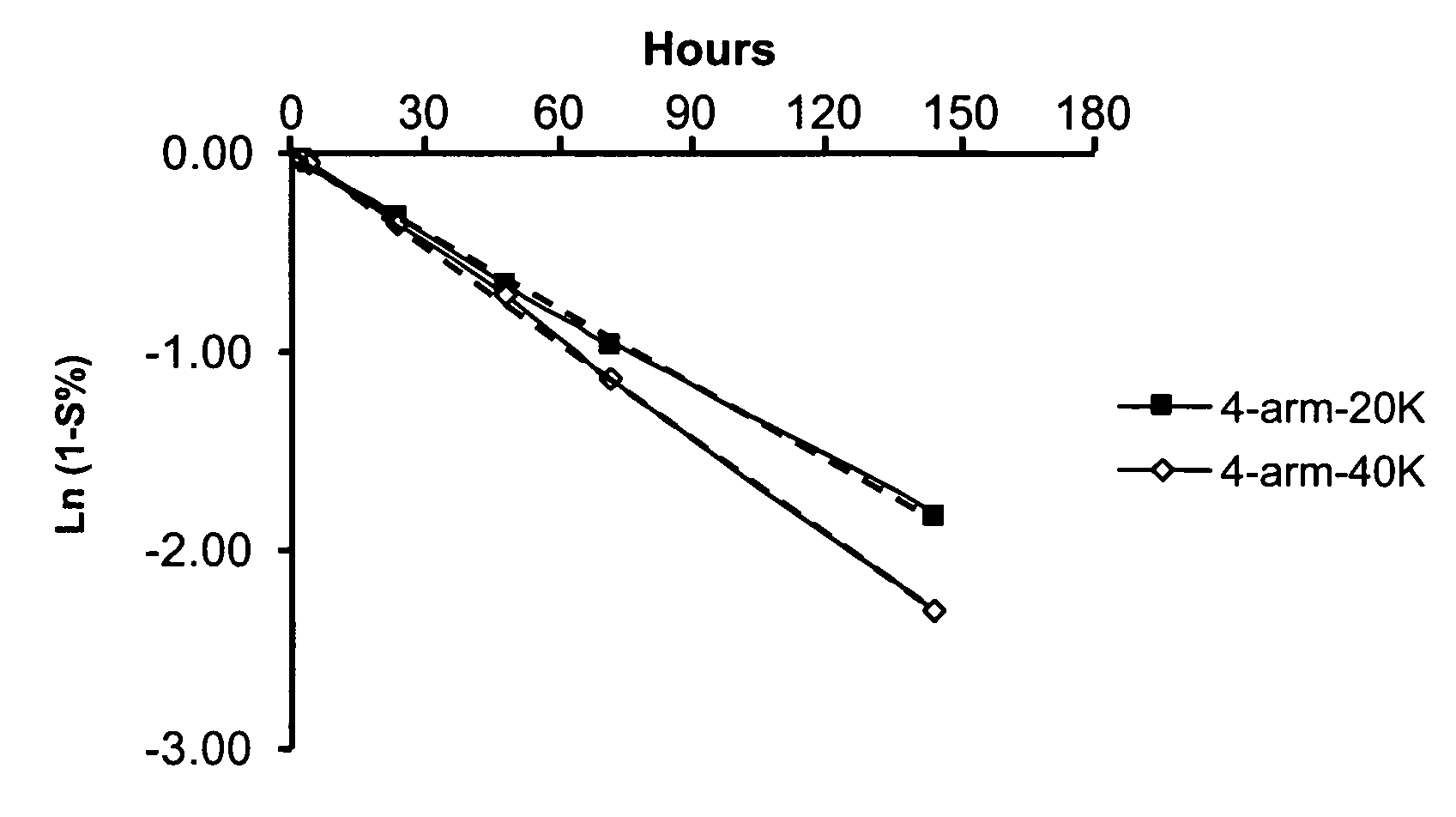Polymer-based compositions and conjugates of non-steroidal anti-inflammatory drugs
a non-steroidal anti-inflammatory and polymer-based technology, applied in the direction of drug compositions, organic active ingredients, pharmaceutical non-active ingredients, etc., can solve the problems of serious gastrointestinal toxicity, serious gastrointestinal toxicity, and the side effects of nsaid treatment can range from minor to severe, and can sometimes be severe and sometimes fatal,
- Summary
- Abstract
- Description
- Claims
- Application Information
AI Technical Summary
Benefits of technology
Problems solved by technology
Method used
Image
Examples
example 1
Preparation of a 4-arm PEG (20K)-Ketorolac Delivery System
[0213]
[0214] One gram (1.0 g) of ketorolac tris salt was converted to ketorolac by dissolution in 15 mL DI H2O, followed by addition of 30 mL 1N HCl. The resulting solution was stirred until a white solid precipitated. The product was collected by filtration, dried under vacuum, and used in the following synthetic transformations.
[0215] 4-arm-PEG-20K (2.0 g, MW=20 kDa), ketorolac (151 mg), HOBT (11 mg), DMAP (73 mg) and DCC (413 mg) were dissolved in anhydrous CH2CL2 (80 mL) to form a yellow solution which was then stirred at RT overnight. The resulting reaction mixture was filtered to remove any undissolved solids, and the solvent removed by rotary evaporation. IPA (˜200 mL) was then added to the remaining residue to precipate the product. The product was collected by filtration, and rinsed with ethyl ether. The recovered solid was dried under vacuum overnight. Yield of product (designated JY424, or 4-arm PEG-20K-KETO) was...
example 2
Preparation of a 4-arm PEG (40K)-Ketorolac Delivery System
[0216] Ketorolac was prepared from the corresponding tris salt as described in Example 1. 4-arm-PEG-40K (2.0 g, MW=40 kDa), ketorolac (76 mg), HOBT (6 mg), DMAP (37 mg) and DCC (207 mg) were dissolved in anhydrous CH2CL2 (80 mL) to form a yellow solution which was then stirred at RT overnight. The resulting reaction mixture was filtered to remove any undissolved solids, and the solvent removed by rotary evaporation. IPA (˜200 mL) was then added to the remaining residue to precipate the product. The product was collected by filtration, and rinsed with ethyl ether. The recovered solid was dried under vacuum overnight. Yield of product (designated JY425 or 4-arm PEG-40K-KETO) was 94%. Based upon 1H NMR analysis, the drug loading amount was approximately 2.3% by weight.
example 3
Release Study for 4-arm PEG Ketorolac
[0217] A release study was conducted to examine the release profiles of parent drug, ketorolac, from illustrative multi-arm polymer delivery systems to which the drug was covalently but releasably attached.
[0218] A. Sample Preparation:
[0219] 4-arm PEG-20K KETO: 40.0 mg of 4-arm-20K-Ketorolac (JY424) was dissolved in 10 mL PBS, pH 7.4. After total dissolution, the solution was stored at 37° C. Analysis was based upon HPLC results. On the first day, two HPLC injections were carried out, thereafter, one injection was made daily to provide the release profile reported herein.
[0220] -4-arm PEG-40K KETO: The sample was prepared in an identical fashion to 4-arm-20K-KETO.
[0221] B. Analytical Method
[0222] An HPLC method was employed to determine release profiles using a two-solvent gradient system. Solvent A was 0.1% TFA in H2O; Solvent B was acetonitrile. A UV detector was employed at a wavelength of 280 nm. Release of unmodified parent drug from t...
PUM
 Login to View More
Login to View More Abstract
Description
Claims
Application Information
 Login to View More
Login to View More - R&D
- Intellectual Property
- Life Sciences
- Materials
- Tech Scout
- Unparalleled Data Quality
- Higher Quality Content
- 60% Fewer Hallucinations
Browse by: Latest US Patents, China's latest patents, Technical Efficacy Thesaurus, Application Domain, Technology Topic, Popular Technical Reports.
© 2025 PatSnap. All rights reserved.Legal|Privacy policy|Modern Slavery Act Transparency Statement|Sitemap|About US| Contact US: help@patsnap.com



